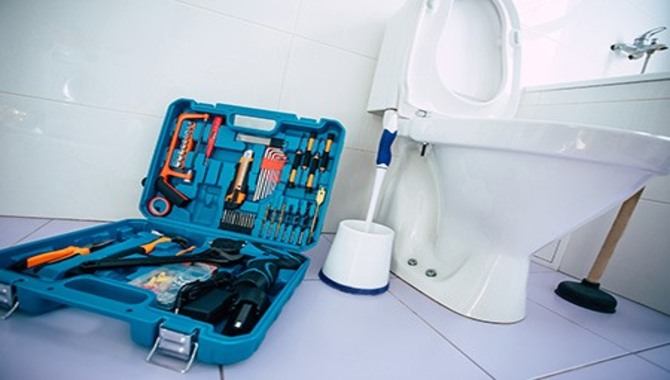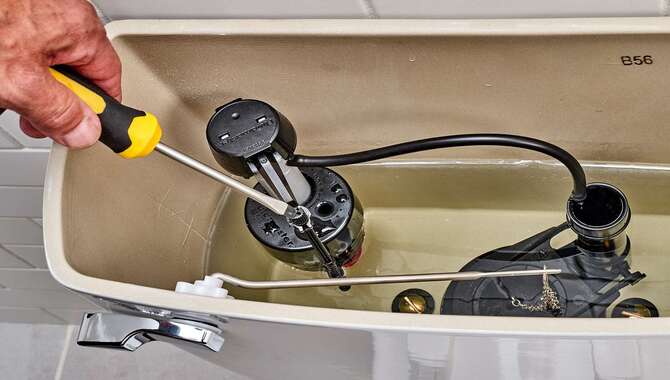A running toilet can be a frustrating and wasteful problem to deal with. Not only does it make an annoying sound, but it can also waste a significant amount of water over time.
Fortunately, fixing a running toilet is usually a simple task that anyone can do with the right tools and knowledge. The constant sound of water running can keep you up at night and increase your water bill significantly. Fortunately, fixing a running toilet is often an easy DIY task that requires only essential tools and some knowledge about how to fix a running toilet work.
We will guide you through the troubleshooting process to help you identify the cause of your running toilet and provide simple solutions. From adjusting the float to diagnosing a leak, we will cover everything you need to know to get your toilet back in working order.

How To Fix A Running Toilet – Simple Ways

Fixing a running toilet may seem daunting, but some simple ways exist to address the issue. The first step is to locate the source of the problem, which could be a faulty flapper valve. A loose or damaged fill valve, or a leaky gasket.
Once you have identified the culprit, you can then take steps to fix it. For example, if the flapper valve is not sealing correctly, you may be able to adjust it by tightening or loosening the chain that connects it to the flush handle.
Alternatively, if the fill valve is leaking or not filling correctly, you may need to replace it with a new one. With some essential tools and know-how to fix a running toilet can be a quick and easy DIY project to save money on water bills and help conserve this precious resource.
1. Tools Needed To Fix A Running Toilet

Having the right tools is crucial for fixing a constantly running toilet. Grab an adjustable wrench and pliers to tighten or loosen nuts and bolts quickly. Don’t forget to have a screwdriver to remove screws and small parts if necessary.
A toilet repair kit containing replacement parts like a fill or flush valve is also essential. Ensure a watertight seal around the base of your tank or between it. And the bowl, use plumber’s putty or silicone caulk. With these items, you can quickly fix any issue your running toilet is experiencing.
2. Troubleshooting A Toilet Valve
If your toilet is constantly running, it could be due to a faulty fill valve or an issue with the flush valve but don’t worry! Troubleshooting a toilet valve is easy with these simple steps. Firstly, check that the toilet flapper or valve is sealed correctly.
Inspect the float arm and ball for correct function and adjust water levels in the tank to avoid overflow. If necessary, replace damaged components like the flapper or valve. If you’re still stuck, don’t hesitate to call a professional plumber for assistance.
3. Identifying A Faulty Toilet Flapper
Identifying a faulty toilet flapper is crucial if you have a constantly running toilet. Weak flushing or water leaking into the bowl are common signs of a faulty flapper. To check if it’s the issue, you can follow this simple test- add food coloring to the tank and wait for some time.
If it leaks into the bowl, replacing it with a new one can save gallons of water and reduce your water bill significantly. However, if replacing the old flapper with a new one doesn’t fix your problem entirely, there might be potential issues, such as clogs in your toilet trap or problems related to your fill valve.
4. Steps To Adjust A Running Toilet Float

To adjust a running toilet float, turn off the toilet’s water supply line. Next, remove the tank lid and look for the float cup or ball float on top of the water in your toilet tank. The position of this float determines when your fill valve turns on and off.
Adjusting this float height using a screwdriver or pliers can help you maintain your desired water level in your toilet tank and prevent overflow problems. Test and adjust as needed. If adjusting does not solve your problem, check for other potential issues, such as a faulty flapper or valve seal, to avoid water leaks and high water bills.
5. Diagnosing A Toilet Leak
If you suspect a toilet leak, start by checking the water level in the tank. If it’s below the overflow tube, there might be a problem with your valve or flapper. Alternatively, you can add food coloring to the tank and wait for some time. If you see color in the bowl, it indicates a leak.
You can also listen for hissing sounds or check for wet spots around the base or floor of your toilet. Diagnosing and fixing leaks early can prevent extensive water damage and save you from unnecessary repair costs.
6. Common Toilet Flush Issues

Toilet flush problems are common and can be caused by faulty fill valves, clogged flapper valves or mineral buildup. Adjusting float height or replacing fill valves can save water consumption if there is an issue with flushing.
It’s essential to watch for leaks around the tank’s base, which can lead to high water bills. Maintaining your toilet regularly and ensuring your hardware store has proper installation instructions are vital steps towards preventing future issues.
7. Fixing A Weak Flush
If your toilet is experiencing a weak flush, there are several troubleshooting steps you can take before calling a professional plumber. Start by checking that the water level in the tank is at least an inch below the top of the overflow pipe, and clear any potential clogs in the drain hole located at the bottom of the bowl using a plunger or drain snake.
If those don’t work, consider replacing faulty parts such as old flappers or fill valves with newer fluid master ones purchased from hardware stores. Moreover, adjusting valve float height can also be a solution for a constant flow of water, which increases gallons on your bill.
8. Hiring A Professional Plumber

If you’re dealing with a constantly running toilet, it might be time to hire a professional plumber. A trained plumber has the expertise to diagnose and resolve complex issues like faulty fill valves and leaks. Or clogs that may be causing your toilet to run continuously.
Hiring a professional plumber can avoid further damage and higher repair costs. Whether you need a new flapper or fill valve, have the supply line checked or need new installation instructions for an old toilet. Calling on the services of an experienced professional is always a good idea.
When To Call A Plumber For A Running Toilet
Suppose you’ve tried adjusting the flapper or replacing the fill valve. If you still face a constantly running toilet problem, you should contact a professional plumber. Look out for low water pressure, slow drainage, or foul odours; these are signs that it’s time to call for help.
Calling an experienced plumber would help prevent additional damage or costly repairs. Expert plumbers can diagnose and fix complex issues like leaks and clogs—faulty fill valves, and more using their tools and experience. Hiring a professional plumber to fix your running toilet issue saves time and money.
Maintenance Tips For A Running Toilet
Regular maintenance ensures your toilet functions properly and doesn’t waste water. To prevent a constantly running toilet, inspect the components, such as the flapper and fill valve, for any faults.
If you notice a leak or a constant flow of water into the toilet bowl, it may be time to adjust the float in your toilet tank or replace old parts with new ones available at your local hardware store. By taking these steps, you can ensure that your toilet remains in top working condition while saving money on your water bill.
How Often Should You Check Your Toilet Parts?
To keep your toilet functioning optimally, checking the parts at least once every six months is recommended. This includes inspecting the flapper valve, fill valve, and float for any signs of wear and tear.
Additionally, checking for leaks or strange noises can help you identify potential issues early on. I am saving you from costly repairs down the line. By staying vigilant with regular maintenance, you can ensure that your toilet is always running smoothly.
Conclusion
Fixing a running toilet may seem daunting, but it can be a relatively simple DIY project with the right tools and knowledge. By identifying the source of the problem and taking the necessary steps to repair or replace any damaged parts, you can save yourself money on water bills and prevent further damage to your plumbing system.
However, running a toilet can be frustrating and cause increased water bills. Fortunately, you can take a few simple steps to how to fix a running toilet. From troubleshooting the toilet valve to identifying a faulty toilet flapper and adjusting the float, our guide covers all the basics.
However, it’s always best to call a professional plumber if you’re not confident in your plumbing skills or if the issue persists. Regular maintenance checks can also help prevent future issues with your running toilet.
Frequently Asked Questions
[rank_math_rich_snippet id=”s-409a45fa-bf7e-457e-8863-0a2292e81a3c”]

I am passionate about home engineering. I specialize in designing, installing, and maintaining heating, ventilation, and air conditioning systems. My goal is to help people stay comfortable in their homes all year long.

